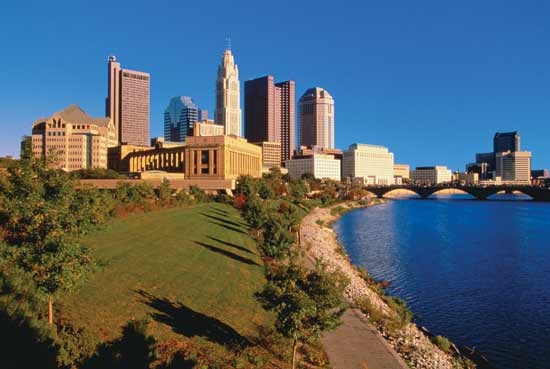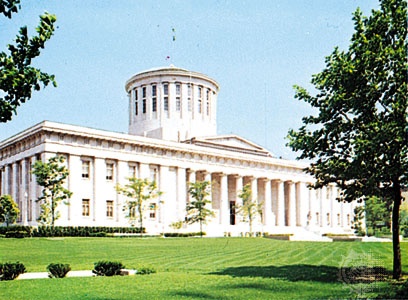Columbus
Georgia, United States
city (since 1971 consolidated with Muscogee county), western Georgia, U.S., at the head of navigation on the Chattahoochee River, opposite Phenix City, Alabama. Founded in 1828 and carved out of the wilderness, it had by 1840 become a leading inland cotton port with a thriving textile industry utilizing power from falls in the river. During the American Civil War it was a major supply city of the Confederacy and was the site of the last battle (April 16, 1865) east of the Mississippi River, leading to its capture by the Union general James H. Wilson. Its Port Columbus Civil War Naval Center houses the salvaged hulls of the Confederate gunboat Chattahoochee and the ironclad ram Jackson, both set afire and sunk in the river during the conflict.
Now highly industrialized, Columbus is one of the largest textile centres in the South; other local manufactures include food products, electrical equipment, aircraft parts, and fabricated metal products. A series of dams and locks on the Chattahoochee, connecting the city's port to the Gulf of Mexico (Mexico, Gulf of), have revitalized river traffic. Fort Benning (1918; named for Confederate General Henry L. Benning, a Columbus native), just to the south, is the site of the U.S. Army Infantry School and the National Infantry Museum. Columbus State University was opened in 1958. Blues singer Ma Rainey (Rainey, Ma) and novelist Carson McCullers (McCullers, Carson) were natives of Columbus. Inc. 1828. Pop. (1990) city, 178,681; Columbus MSA, 260,860; (2000) city, 186,291; Columbus MSA, 274,624.
Indiana, United States
city, Bartholomew county, south-central Indiana, U.S., on the East Fork White River, 43 miles (70 km) south of Indianapolis. Founded in 1821 as the county seat, it was named Tiptona for General John Tipton, who had given the land to the county, but a month later it was renamed Columbus. A diversified industrial community surrounded by productive prairie land, it is known for its distinctive architecture, with many buildings designed by distinguished architects such as the Saarinens, Harry Weese, Robert Trent Jones, Robert A.M. Stern, and I.M. Pei. Two of its more-notable edifices are the First Christian Church (1942; designed by Eliel Saarinen) and the North Christian Church (1964; designed by Eero Saarinen). Many of the designs were financed through a fund established in 1957 by the Cummins Engine Co., which is headquartered in Columbus. Manufacturing is centred on auto parts and engines, as well as furniture, plastic products, and pharmaceuticals. Indiana University–Purdue University Columbus is also located in the city. Camp Atterbury, 10 miles (16 km) northwest of the city, is the site of National Guard training exercises and the Civil Air Patrol's National Ground Search and Rescue School. Inc. town, 1837; city, 1864. Pop. (2000) city, 39,059; Columbus MSA, 71,435; (2005 est.) city, 39,380; (2004 est.) Columbus MSA, 72,987.
Mississippi, United States
city, seat (1830) of Lowndes county, eastern Mississippi, U.S., on the Tombigbee River, about 90 miles (145 km) north of Meridian, near the Alabama border. Settled as a trading post (1817), it was known until 1821 as Possum Town. In 1822 the steamboat Cottonplant first docked in Columbus, then a port of entry. During the American Civil War the Confederates maintained a large arsenal in the town, which served as a temporary state capital when the city of Jackson fell to Union forces in 1863. Decoration Day, later observed nationally as Memorial Day, originated there at Friendship Cemetery on April 25, 1866. Many antebellum homes survive and can be visited during the annual spring pilgrimage.
Columbus is an important trade centre for the surrounding agricultural region. The economy is augmented by manufactures (including automotive parts, plumbing products, furniture, paper, and wall coverings) and Columbus Air Force Base. The Tennessee-Tombigbee Waterway Development Authority (1958) is headquartered in Columbus. Mississippi University for Women originated there in 1884 as the Industrial Institute and College (the first American state-supported college for women), and the city's Franklin Academy (1821) was Mississippi's first free public school. The playwright Tennessee Williams (Williams, Tennessee) was born (1911) in Columbus, and his home has been preserved. Inc. town, 1821; city, 1884. Pop. (1990) 23,799; (2000) 25,944.
Nebraska, United States
city, seat (1857) of Platte county, eastern Nebraska, U.S., on the Loup River near its confluence with the Platte, about 85 miles (135 km) west of Omaha. Pawnee, Omaha, and Oto Indians were early inhabitants of the area. Columbus was founded in 1856 on the proposed railroad route by settlers from Columbus, Ohio. It became an outfitting post for westbound wagon trains with ferries on the river; the arrival of the Union Pacific Railroad (1866) contributed to its growth. Its modern economy is based on agriculture (cattle, hogs, dairy products, corn 【maize】, and soybeans), railroad operations, and the manufacture of farm equipment, electronics, automotive parts, and medical equipment; it is also a regional retail centre. Several public power agencieshave their headquarters in Columbus, and nearby lakes North and Babcock are reservoirs for the Loup Power District's two hydroelectric plants, located on the 35-mile (55-km) Loup River Canal. A campus of Central Community College is located there. Inc. town, 1865; city, 1873. Pop. (2000) 20,971; (2005 est.) 20,909.
Ohio, United States
Introduction
 city, Franklin, Fairfield, and Delaware counties, capital (1816) of Ohio, U.S., and seat (1824) of Franklin county. It is situated in the central part of the state on the relatively flat Ohio till plain, at the junction of the Scioto (Scioto River) and Olentangy rivers. Columbus is at the centre of a metropolitan complex that includes Dublin (northwest), Gahanna and Westerville (northeast), Reynoldsburg (east), and Grove City (southwest); several municipalities, including Upper Arlington, Worthington, Bexley, and Whitehall, are wholly or largely surrounded by the city. Inc. city, 1834. Area city, 213 square miles (552 square km). Pop. (2000) city, 711,470; Columbus MSA, 1,540,157; (2006 est.) city, 733,203; Columbus MSA, 1,734,563.
city, Franklin, Fairfield, and Delaware counties, capital (1816) of Ohio, U.S., and seat (1824) of Franklin county. It is situated in the central part of the state on the relatively flat Ohio till plain, at the junction of the Scioto (Scioto River) and Olentangy rivers. Columbus is at the centre of a metropolitan complex that includes Dublin (northwest), Gahanna and Westerville (northeast), Reynoldsburg (east), and Grove City (southwest); several municipalities, including Upper Arlington, Worthington, Bexley, and Whitehall, are wholly or largely surrounded by the city. Inc. city, 1834. Area city, 213 square miles (552 square km). Pop. (2000) city, 711,470; Columbus MSA, 1,540,157; (2006 est.) city, 733,203; Columbus MSA, 1,734,563.History
Columbus was planned in 1812 as a political centre by the Ohio legislature and was named for Christopher Columbus (Columbus, Christopher). The state government moved to the city in 1816 from Chillicothe, and Columbus later absorbed the nearby earlier settlement of Franklinton (founded 1797). The city experienced significant growth after a feeder branch of the Ohio and Erie Canal was opened to it in 1831 and the Cumberland (National) Road (Cumberland Road) from Maryland reached it in 1836. The first railroad arrived in 1850, further stimulating development.
During the American Civil War, Columbus became a major staging area for Union forces, and Camp Chase, one of the North's largest facilities for Confederate prisoners of war, was built on the city's west side. The local economy continued to boom after the war. Columbus became one of the country's major manufacturers of horse-drawn vehicles. By 1900, when the population exceeded 125,000, the city had emerged as an important transportation and commercial centre. Following damaging floods in 1913, the Scioto River was widened and levees, retaining walls, and bridges constructed, which allowed riverfront development.
Unprecedented industrial growth occurred after 1940. A large aircraft plant established there provided the initial stimulus, but many branches of national companies were also attracted to the area. Columbus continued to grow in size mainly because it pursued a policy of annexing adjacent land; between 1950 and 2000 the city's land area increased fivefold, and its population nearly doubled. By 1990 it was Ohio's largest city. People of European ancestry have long constituted the great majority of its residents, but the African American proportion of the population has steadily increased to about one-fourth of the total.
The contemporary city
 Services (banking and finance, insurance, government, and education) now constitute the major part of the city economy. High-technology industries and manufacturing (automobiles, motorcycles, communications equipment, steel and steel products, and nutritional supplements) are also important. The city's favourable geographic position has been enhanced by the presence of main-line railroads, an extensive highway network, and an international airport.
Services (banking and finance, insurance, government, and education) now constitute the major part of the city economy. High-technology industries and manufacturing (automobiles, motorcycles, communications equipment, steel and steel products, and nutritional supplements) are also important. The city's favourable geographic position has been enhanced by the presence of main-line railroads, an extensive highway network, and an international airport.The main campus of Ohio State University (1870) occupies a large site north of downtown. Other institutions of higher learning include Franklin University (1902), Capital University (1830), Ohio Dominican College (1911), Otterbein College (1847), Pontifical College Josephinum (1888), Columbus College of Art and Design (1879), Columbus State Community College (1963), and state schools for the hearing and visually impaired. Notable research organizations are Battelle Memorial Institute (1929; technology), the Orton Ceramic Foundation, and the Chemical Abstracts Service. The federal government operates a large military supply centre and other facilities. Many of the state's institutions and offices and the state fairgrounds are in the city. The Ohio Statehouse (a limestone structure in Doric style, completed in 1861) has a monument by sculptor Levi Tucker Scofield.
Also of interest are the McKinley Monument, Camp Chase Confederate Cemetery, the Ohio Historical Center (1970) and adjacent Ohio Village outdoor museum, and COSI Columbus, a science and industry centre. The city supports an art museum and a symphony orchestra. The home of author James Thurber (Thurber, James) is preserved as a literary centre. The city maintains a large park system, and there is a conservatory and botanical garden east of downtown and a zoo northwest near Dublin. Area reservoirs (including Griggs, O'Shaughnessy, and Hoover) are also popular recreational venues, as is Alum Creek State Park north of the city. Scioto Downs and Beulah Park have horse racing. Annual events include an arts festival (June), the state fair (August), and Oktoberfest (September; based at the restored 19th-century German Village area south of downtown). Olentangy Indian Caverns, just north of the city, has caves once used by Iroquoian-speaking peoples.
- Gerry Mulligan
- Gersh Itskovich Budker
- Gershom ben Judah
- Gershwin, George
- Gershwin, Ira
- Gerson, Jean de
- Gerstenberg, Heinrich Wilhelm von
- Gerstner, Lou
- Gert Fredriksson
- Gert Hofmann
- Gertrude Atherton
- Gertrude B. Elion
- Gertrude Bell
- Gertrude Berg
- Gertrude Bonnin
- Gertrude Caton-Thompson
- Gertrude Ederle
- Gertrude Jekyll
- Gertrude Käsebier
- Gertrude Lawrence
- Gertrud Elisabeth Mara
- Gertrude Stein
- Gertrude Vanderbilt Whitney
- Gertrudis Barcelo
- Gertrudis Gómez de Avellaneda